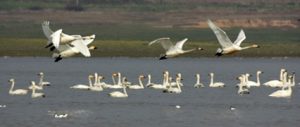Wildlife photographers and bird watchers gathered at the Beidagang Wetlands Nature Reserve in Tianjin last month were shocked to find a poisoned flock of Oriental White Storks, a protected species. At least 22 of the birds were dead.
It was later found that 100 other birds, including mallards, Eurasian teals, spot-billed ducks and grey herons had also died. Tianjin police offered a reward of 50,000 yuan for help in their search for the criminals. However, the truth behind the death is, perhaps, far more complex than a hunt for a band of poachers.
A large proportion of the world’s 10,000 bird species are migratory. China lies in the northern hemisphere, so its birds usually fly north in the spring and return to the south in autumn.
“If they don’t get killed here, they’ll get killed somewhere else,” is how Hunan bird conservation volunteer Li Feng describes the way the migratory birds are hunted en route. From September this year he and two other volunteers have been secretly observing mountain passes in Dudong county, which the birds must pass through. Hunters are out every night with guns and powerful lights.
On the other side of the pass lies Yingpanxu, in Jiangxi. The locals there take pride in their hunting skills, and it is tradition that the first solid food a child eats after weaning is bird stew. Bird hunting is seen as a cultural tradition here, and during the season people will even travel back from their jobs in the cities to join in.
There are similar stories to be told on other migratory routes in Sichuan, Yunnan, Guizhou and Guangxi. At Shidu, to the south-west of Beijing, migrating birds, and in particular birds of prey, must travel through passes in the mountains. Hunters lie in wait there with nets. Every year volunteers from the Black Leopard Wildlife Conservation Station patrol key points during the hunting season, in order to stop hunting.
Word leaked out recently of another poisoning of the Oriental White Stork, at a saltworks outside Tangshan, Hebei. Fourteen storks died at the same location in 2004, again from poisoning. And an environmentalist in Shandong has found that the Great Bustard, like the stork a protected species, is being hunted at locations along the Shandong-Henan border.
The wetlands of Poyang Lake in Jiangxi are important wintering grounds for white storks and young swans. The biggest headache for local forestry authorities is the nets erected by hunters all over the wetlands in order to catch birds. A crackdown might result in fewer nets being seen for a while, but before long things are back to normal.
Killing for the mouths of consumers
“Why do people hunt birds? Because other people eat them,” explains Ma Ming, deputy chair of the China Ornithological Society and a researcher at the Xinjiang Institute of Ecology and Geography.
Ma has worked out that a wild duck caught in Urumuqi can be sold for about 30 yuan. Transport it to Changsha or Guangzhou and the price leaps tenfold – and will increase several times over by the time it reaches a restaurant table. In Guangzhou markets a goose or swan will sell for over a thousand yuan.
Ma’s research has covered the entire country outside of Tibet. He has found poachers are most active in Liaoning, Xinjiang, Henan, Shandong, Hubei, Hunan and Jiangxi. Birds caught in the north are mostly transported south, to restaurants in Guangzhou, Shenzhen, Ningbo and Changsha. Wild birds are often transported as poultry, six to eight hundred birds in a batch. The poachers will also chase the birds around the country – wherever they fly to, the poachers will follow.
Eight boxes of corpses, totalling 618 birds, were recovered in a poaching bust in Hunan this October. Yin Hong, deputy head of the State Forestry Administration said that poaching is often tied up with the illegal food trade. In several recent cases the destination for poached animals was almost always restaurant kitchens. In some areas poaching and consumption of wild animals is not rare at all, but an open and common practice – and becoming even more frequent.
Bird conservation starts with bird habitats
An even greater threat to migratory birds is the disappearance of their habitats.
Su Liying, an expert with the International Crane Foundation, refers to an International Union for Conservation of Nature (IUCN) report on East and Southeast Asian intertidal habitats, which was published this year. The report found that 155 species of waterfowl use these flyways, and at least 33 are globally threatened or near threatened. The report evaluated 388 coastal sites used by waterfowl, finding that bird numbers were dropping by between 5%-9% annually, a rate he says is “among the highest of any ecological system on the planet”.
Over the last 50 years, the IUCN also reported that 51% of China’s wetlands have been lost. And a further 40% in Japan, 60% in Korea 60% and 70% in Singapore.
Jie Yan, a researcher with the Institute of Biology of the Chinese Academy of Sciences, says that a failure to build China’s nature reserve system and legislation is the main reason wildlife is not getting the protection needed. New methods, including building “community reserves”, encouraging private reserves, and strengthening links between government reserves and the locals, are all worth trying.
Zhang Zhengwang, secretary-general of the China Ornithological Society and a professor at Beijing Normal University, says that China’s many bird-watching groups are becoming an important force in bird conservation.
While stronger law enforcement and harsh penalties for those catching, killing, selling and eating the birds are important, he says forestry and environmental authorities should work more closely with bird-watching groups in pushing for more nature reserves.




